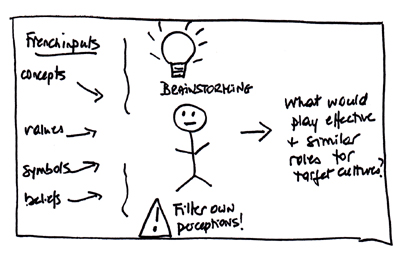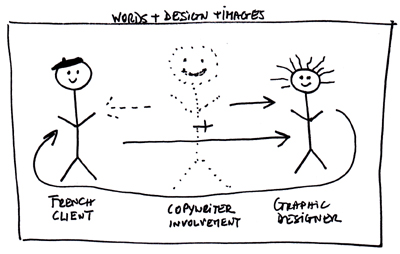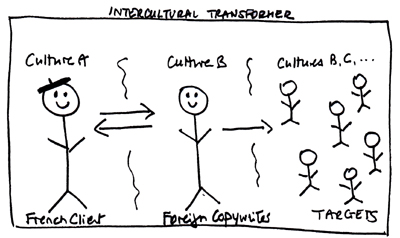Teaching intercultural copywriting
 When l‘INALCO (the National Institute for Oriental Languages and Civilisations), one of France’s grandes écoles, asked me a few months ago if I’d be interested in teaching a course on intercultural copywriting for their MA in intercultural communications, I thought “hmm…that should be fun!”
When l‘INALCO (the National Institute for Oriental Languages and Civilisations), one of France’s grandes écoles, asked me a few months ago if I’d be interested in teaching a course on intercultural copywriting for their MA in intercultural communications, I thought “hmm…that should be fun!”
This new Masters programme aims to introduce students to the field of intercultural communications and to the variety of careers involved. Students come from all over the world and courses are taught in French.
Teaching intercultural copywriting without writing
Yet this is not supposed to be a writing class and I couldn’t assess most of their prose anyway! My future students’ native languages include Russian, Urdu, Japanese, Hindi and Peul; a few are native French speakers, none are native English speakers. The goal is to introduce them to what copywriting is (and there are many different types), how a copywriter works, and with the field of intercultural communications — all this in 12 hours (gasp!) Would this field be a good career choice for them?
Focus on the “how”, not the “what”
So I’m going to introduce them to a copywriting project’s life-cycle and participants.
A copywriting project never takes place in a vacuum, with the copywriter working his or her magic alone with total control over all aspects of the project, upstream and downstream. All the more so when providing clients with copy in a language that is not theirs and for a readership whose culture may be unfamiliar.
I picked apart some of the work I’ve done to show how, at every point in a copywriting project, various cultural influences come into play that must be noticed, understood, integrated or countered to make sure the copy achieves its goals. In that, the copywriter is not just a talented pen who is writing in a foreign language for a foreign culture: he or she is the pivot and filter and must take on an advisory role with the client. As you’ll see, an intercultural copywriter is also teacher, diplomat, negotiator and orchestrator.
To make things more vivid, I sketched the main phases. OK, I’m not talented like Mox, but you’ll get the ideas.
I picked a relatively simple example, where the copywriter is working directly with the one decision maker. The process can be even more complicated when working with a full client team (representing one or several cultures) and/or alongside a communications agency.
Phase 1: the intercultural brief
[wpcol_2third id=”” class=”” style=””]
[/wpcol_2third] [wpcol_1third_end id=”” class=”” style=””]
Challenges
Intimate understanding of the client’s (source) culture
Intimate understanding of the targets’ culture(s)
Ability to filter out your own inputs/influences
[/wpcol_1third_end]
Phase 2: first drafts and client feedback
[wpcol_2third id=”” class=”” style=””] 
[/wpcol_2third] [wpcol_1third_end id=”” class=”” style=””]
Challenges
Determining the key values your client wants to transmit
Researching their relevance in the target culture(s)
Finding corresponding ones to play the same resonating role
Explaining to your client why ‘transposing’ misses the mark
[/wpcol_1third_end]
Phase 3: design and layout
[wpcol_2third id=”” class=”” style=””] 
[/wpcol_2third] [wpcol_1third_end id=”” class=”” style=””]
Challenges
Be the pivot in the design process
Mediate client inputs to designer
Design as an intercultural communications vehicle
Working w/ designer to offer client a coherent integrated concept
[/wpcol_1third_end]
Phase 4: galleys and review
I’ll spare your eyes another of my fabulous drawings! You’d think that by the time you were handed the galleys, all the issues would be squared away, right?
Rarely.
Funny things happen in the final production stages. Well-intentioned CAD operators might “correct” typography, split words in the wrong place, forget to consult the check-list you carefully prepared to make sure they knew what to watch out for in working on a document they don’t understand. Or the client might have asked for last-minute changes without consulting you that you just cannot sign-off on. Translators run into this all the time.
[wpcol_1third id=”” class=”” style=””]It’s the translation or foreign language copywriting equivalent of a cheese soufflé that falls before coming out of the oven.[/wpcol_1third] [wpcol_2third_end id=”” class=”” style=””]You’re frustrated. The deadline is looming (dinner guests are about to arrive) and you can’t serve this up.
It is up to you, still, to display formidable diplomatic skills to get the production team to correct the bloopers and, as the case may be, to convince your client why his “little changes” might have unintended consequences.[/wpcol_2third_end]
A winning project is one where you are proud to see your by-line in print and that resonates with your client’s target readers.
Do you have challenging examples my students could chew on? I’d love to hear from you in the comments.
And if you liked this post (yeah, maybe even the sketches…), share it!
Tags: Intercultural communications, linkedin, project phases, siteEN, teaching copywriting, Writing






Teaching intercultural copywriting to international students – http://t.co/gyCfyrHG @lokahiandquill #xl8 #techcomm
Teaching #intercultural #copywriting http://t.co/e2PciLxH by @lokahiandquill I like the drawings very much, they speak for themselves 😉
[…] copywriting projects particularly challenging and what soft-skills must the copywriter leverage?Via interculturalzone.lokahi-interactive.com Like this:LikeBe the first to like this […]
[…] When l'INALCO (the National Institute for Oriental Languages and Civilisations), one of France's grandes écoles, asked me a few months ago if I'd be interested in teaching a course on intercultural… […]